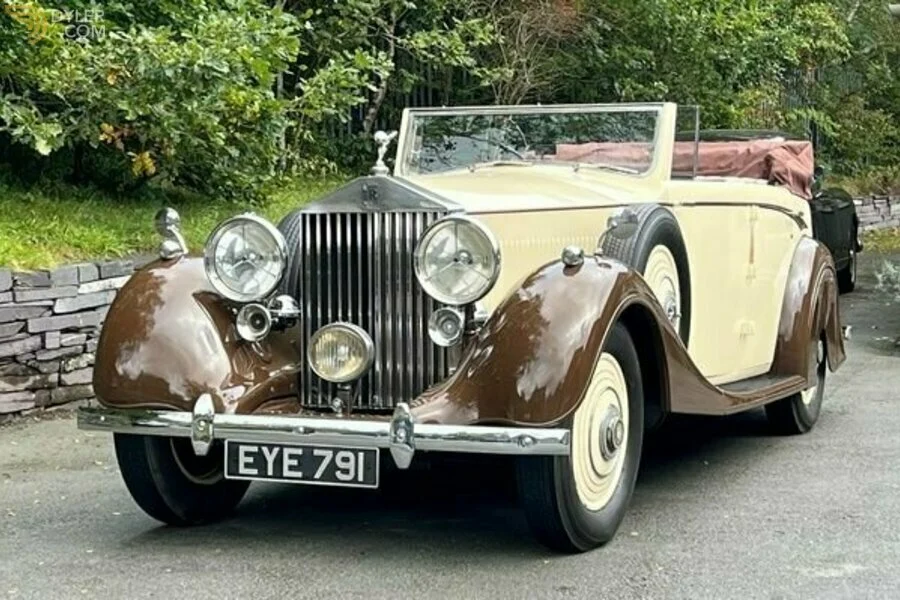The 1937 Rolls-Royce Phantom III Mulliner Sedanca de Ville
The 1937 Rolls-Royce Phantom III Mulliner Sedanca de Ville
In the annals of automotive history, certain vehicles stand out not just for their technical prowess but for their embodiment of luxury and sophistication. Among these, the 1937 Rolls-Royce Phantom III Mulliner Sedanca de Ville is a quintessential example. This model represents the zenith of pre-war automotive design, combining unparalleled craftsmanship with engineering excellence. To appreciate the significance of the 1937 Rolls-Royce Phantom III Mulliner Sedanca de Ville, one must delve into its design, engineering, and the broader context of its era.
Historical Context and Significance
The 1937 Rolls-Royce Phantom III Mulliner Sedanca de Ville was conceived during a period of significant global upheaval. As the world grappled with the repercussions of the Great Depression and the ominous rise of geopolitical tensions, Rolls-Royce, a name synonymous with opulence and engineering brilliance, continued to thrive. The Phantom III, introduced in 1936, was Rolls-Royce’s response to the demand for both performance and luxury in a single package.
The Phantom III was the last model to feature the classic pre-war chassis design and was positioned as the pinnacle of luxury. Its production spanned from 1936 to 1939, during which only 727 units were made, making it a rare and highly sought-after collector’s item today. The 1937 Rolls-Royce Phantom III Mulliner Sedanca de Ville represents one of the most exquisite variations of this model, combining Rolls-Royce’s engineering prowess with the bespoke craftsmanship of Mulliner, a renowned coachbuilder.

Design and Coachwork
The Mulliner Sedanca de Ville body style is a testament to the art of coachbuilding. The Sedanca de Ville is a distinctive design that features a two-door configuration with a convertible roof over the rear compartment, offering passengers a blend of open-air and enclosed luxury. This design was particularly favored by the elite, providing both elegance and practicality.
Mulliner, established in 1760, was one of the foremost coachbuilders of the time, and their work on the Phantom III was exceptional. The craftsmanship of the Mulliner Sedanca de Ville is evident in its elegant lines, the quality of the materials used, and the attention to detail in every facet of its construction. The car’s streamlined body, gracefully curved fenders, and opulent interior reflect a timeless aesthetic that remains highly prized by collectors.
Engine and Performance
The heart of the 1937 Rolls-Royce Phantom III Mulliner Sedanca de Ville is its advanced 7.3-liter V12 engine. This engine was a marvel of engineering, providing a smooth and powerful driving experience that was unrivaled at the time. The V12 configuration allowed for exceptional performance while maintaining the hallmark smoothness and silence of a Rolls-Royce.
The Phantom III’s engine
The Phantom III’s engine was paired with a four-speed automatic gearbox, a pioneering feature that offered greater ease of driving compared to the manual transmissions common at the time. The combination of a powerful engine and sophisticated transmission allowed the Phantom III to achieve a top speed of around 100 mph, a remarkable feat for a car of its size and luxury.
Interior and Luxury
Inside the 1937 Rolls-Royce Phantom III Mulliner Sedanca de Ville, luxury is paramount. The interior is a masterpiece of craftsmanship, featuring rich leather upholstery, exquisite wood veneers, and meticulous attention to detail. The cabin was designed to offer the utmost comfort and refinement, with amenities that catered to the needs of the discerning elite.
Passengers were treated to plush seating, ample legroom, and a host of bespoke features tailored to individual preferences. The Sedanca de Ville’s rear compartment was particularly designed to offer a serene and luxurious environment, with its convertible roof allowing occupants to enjoy the open air or remain sheltered as desired.
Legacy and Collectibility
The 1937 Rolls-Royce Phantom III Mulliner Sedanca de Ville stands as a testament to an era of automotive excellence and artistry. Its rarity, combined with its exquisite design and engineering, has cemented its status as a highly collectible classic car. Enthusiasts and collectors value these vehicles not just for their historical significance but for the unparalleled craftsmanship and luxury they represent.

Restoration and preservation of these vehicles require a deep understanding of their intricate details and a commitment to maintaining their original grandeur. Each 1937 Rolls-Royce Phantom III Mulliner Sedanca de Ville tells a story of a bygone era, reflecting the pinnacle of automotive design and luxury from the late 1930s.
Conclusion
The 1937 Rolls-Royce Phantom III Mulliner Sedanca de Ville is more than just a car; it is a symbol of a time when automotive design reached its zenith. Its combination of advanced engineering, luxurious design, and bespoke craftsmanship makes it a masterpiece that continues to captivate and inspire. As one of the rarest and most sought-after models in the Rolls-Royce heritage, it remains a shining example of the elegance and innovation that define the brand. For collectors and enthusiasts alike, the 1937 Rolls-Royce Phantom III Mulliner Sedanca de Ville represents a cherished piece of automotive history, a timeless icon of luxury and sophistication.




